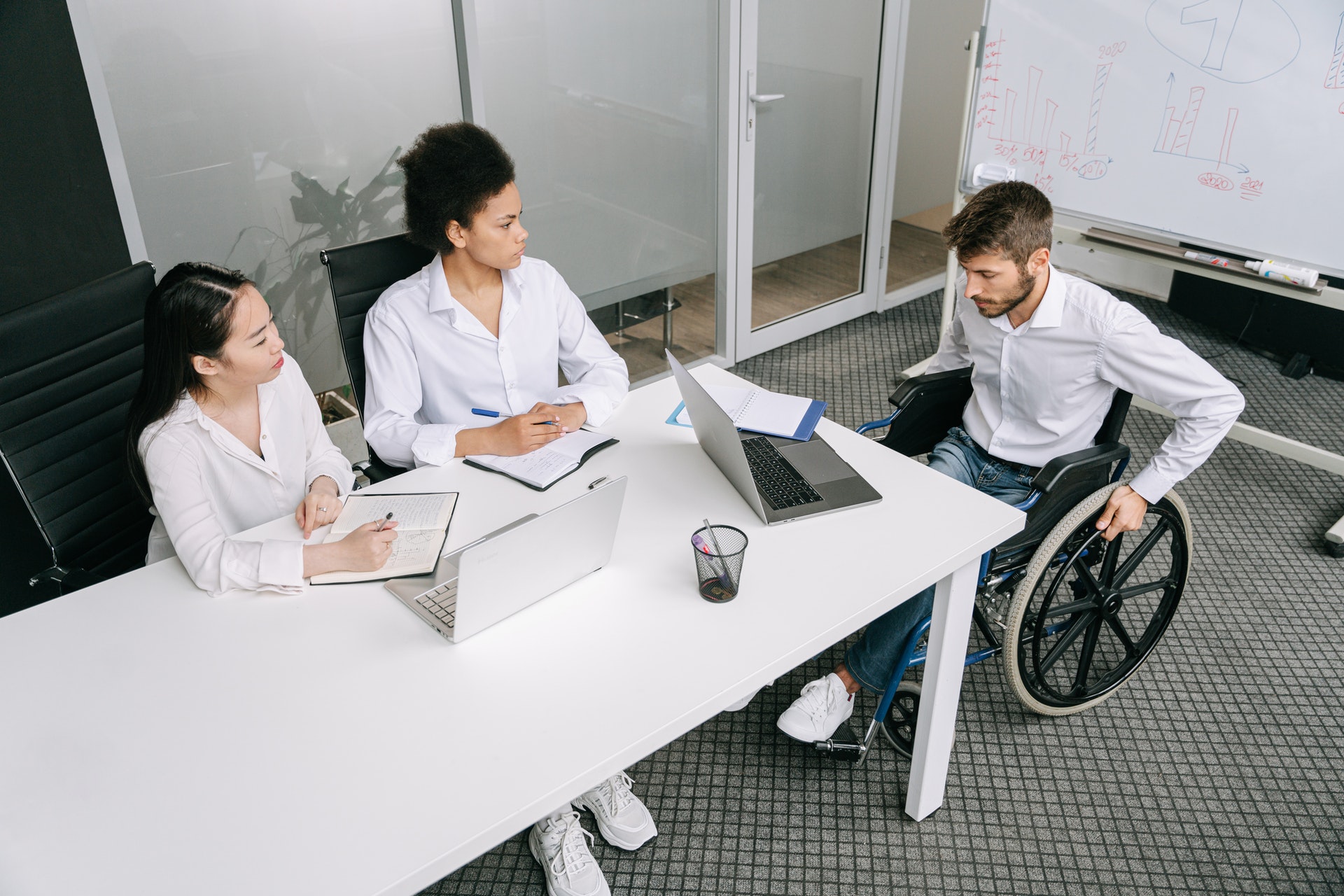It might have seemed strange to list the physical office as an employee benefit three years ago.
Digital innovation and the hybrid model now make it a reality.
The remote workplace has redefined how we work, and made us question what the office is actually doing for us. Is it just to make it easier for managers to keep surveillance on employees? A place to get away from the house? A place to eat bland salads?
First, let’s get honest about how we really felt about the physical office
It’s probably safe to say most people weren’t thrilled to come to the office every day.
Very few of us lost sleep Sunday night because we were excited about the Monday morning commute. Most of us probably didn’t like wearing (and buying) ‘business casual’ clothes. And it’s probably safe to say that no one misses the cubicles, artificial lighting, and packed lunches.
Remote work solved a lot of those problems. The post-COVID ‘lift-off’ might have come with numerous challenges, but it was worth it. In fact, it solved more issues than most people think.
Remote work models offloaded many physical office negatives to the digital environment
Before COVID restrictions hit, the office was the nucleus of the business. Managers delegated projects, measured productivity, and administered training programs while we built company culture around daily activities and special events.
Some of these aspects were enjoyable while others were challenging, including:
Project and Task Management
Managers kept track of projects and surveilled employees to ensure everything was completed. Progress was communicated verbally throughout the day, so documentation was low.
Today, most of that work is delegated to workflow tools that provide full visibility. In addition, non-invasive asynchronous communication lets us know who is responsible for what, and everyone is kept in the loop.
Productivity Measurement
Face time was a dominant productivity measurement factor in the traditional physical office. We were expected to be at the office by a specific time, and management required that we stay for a set number of hours.
This wasn’t always fair. Employees who put in more hours often looked like they were the most productive — even if they were wasting time. This created an uneven playing field that punished more efficient employees that maximized their effort so they could leave earlier.
The hybrid model frees us from this problem with platforms that measure productivity based on completed tasks instead of hours worked. Total surveillance and micro-management are not required because employee activity is completely transparent. This allows managers to measure productivity with effort instead of attendance, giving employees the freedom to maximize efficiency and achieve a better work-life balance.
Employee Training
Even before COVID, most employee training was either partly or entirely online. Things only got better in the post-COVID era with modern learning management software that provides better learning experiences with structured learning paths, interactive content, and data-enhanced features that help administrators gauge the success of their programs.
The digital workplace gave us many solutions to the problems we faced at the physical office. At the same time, a physical office is still required to fill in gaps created in the online environment.
A dedicated physical office has some perks
Digital tools solve some of the most challenging aspects of working at a physical office. With that in mind, we can re-imagine the office to serve specific functions:
Physical offices build culture
The physical office is a place to connect and have authentic conversations that include non-verbal cues like facial expressions and body language. The office is also a storehouse of memories where birthdays, anniversaries, and achievements are celebrated.
While not the only way to build culture, meeting physically makes it easier to:
- Create and promote company culture
- Build community
- Create alignment across teams
- Develop camaraderie
- Have water cooler talk
Getting together adds speed to collaboration
Online collaboration with digital tools streamlines and delegates tasks effectively. But there’s always a latency issue. When you are working asynchronously, it’s hard to start a ‘friction fire’ of ideas. One idea rarely rapidly creates another one.
All collaboration doesn’t have to be fast, but it the physical office is great when it is used to:
- Brainstorm and engage in creative exercises
- Work off each other’s physical energy
- Pick up non-intentional body feedback
- Hold live meetings and quickly make decisions
The home is not productive for everyone
Some people have the luxury of changing their living space to create a dedicated, quiet place to work from. Others are still working off the sofa with kids running around the house.
After more than two years of working from home, many of us feel the need to take a break from our home office. The physical office can serve as a quiet place where we can:
- Focus and get work done
- Take a break from our families and neighbors
- Use equipment we don’t have at our home office
- Separate work and home life
Taking account of all these positive aspects of a physical office can help us create a place that truly fosters creativity and collaboration — needs that can never be met from a workflow tool or digital application.
“What do people want from work today? Belonging, meaning, continuity, community…More than an amalgam of ergonomic furniture and meeting rooms. An office, for some people, holds the promise of genuine emotional fulfillment.”
Anne Quito, Quartz
Customize the office to serve your unique needs
Question the purpose of your office when re-creating the space. Is it a place for new hires and fresh college graduates to learn from their experienced colleagues? Is it a platform for collaboration and idea generation? Or is it a place that offers equipment employees don’t have at home?
Create an intention for the physical office that aligns with your goals. For example, it should be a highly collaborative space if you want people to come to the office to work together, share ideas, and hold productive meetings. Likewise, if you want to offer people a place to do focused work, the environment should encourage that.
The office as a perk?
How would you describe your office as a perk when giving a job description? Would you emphasize the quiet, soundproof pods where you can get a lot of focus work done? Or would you talk about the large team rooms with natural light where you can have highly innovative meetings? What about your office is its unique selling point to people who are used to working in sweatpants?
The digital workplace helps us see that the office doesn’t have to do everything. Redefining your HQ gives you the chance to take the best parts of the physical office and create an environment that fosters creativity, enhances collaboration, and builds culture.
Photo by Nastuh Abootalebi on Unsplash
It might have seemed strange to list the physical office as an employee benefit three years ago.
Digital innovation and the hybrid model now make it a reality.
The remote workplace has redefined how we work, and made us question what the office is actually doing for us. Is it just to make it easier for managers to keep surveillance on employees? A place to get away from the house? A place to eat bland salads?
First, let’s get honest about how we really felt about the physical office
It’s probably safe to say most people weren’t thrilled to come to the office every day.
Very few of us lost sleep Sunday night because we were excited about the Monday morning commute. Most of us probably didn’t like wearing (and buying) ‘business casual’ clothes. And it’s probably safe to say that no one misses the cubicles, artificial lighting, and packed lunches.
Remote work solved a lot of those problems. The post-COVID ‘lift-off’ might have come with numerous challenges, but it was worth it. In fact, it solved more issues than most people think.
Remote work models offloaded many physical office negatives to the digital environment
Before COVID restrictions hit, the office was the nucleus of the business. Managers delegated projects, measured productivity, and administered training programs while we built company culture around daily activities and special events.
Some of these aspects were enjoyable while others were challenging, including:
Project and Task Management
Managers kept track of projects and surveilled employees to ensure everything was completed. Progress was communicated verbally throughout the day, so documentation was low.
Today, most of that work is delegated to workflow tools that provide full visibility. In addition, non-invasive asynchronous communication lets us know who is responsible for what, and everyone is kept in the loop.
Productivity Measurement
Face time was a dominant productivity measurement factor in the traditional physical office. We were expected to be at the office by a specific time, and management required that we stay for a set number of hours.
This wasn’t always fair. Employees who put in more hours often looked like they were the most productive — even if they were wasting time. This created an uneven playing field that punished more efficient employees that maximized their effort so they could leave earlier.
The hybrid model frees us from this problem with platforms that measure productivity based on completed tasks instead of hours worked. Total surveillance and micro-management are not required because employee activity is completely transparent. This allows managers to measure productivity with effort instead of attendance, giving employees the freedom to maximize efficiency and achieve a better work-life balance.
Employee Training
Even before COVID, most employee training was either partly or entirely online. Things only got better in the post-COVID era with modern learning management software that provides better learning experiences with structured learning paths, interactive content, and data-enhanced features that help administrators gauge the success of their programs.
The digital workplace gave us many solutions to the problems we faced at the physical office. At the same time, a physical office is still required to fill in gaps created in the online environment.
A dedicated physical office has some perks
Digital tools solve some of the most challenging aspects of working at a physical office. With that in mind, we can re-imagine the office to serve specific functions:
Physical offices build culture
The physical office is a place to connect and have authentic conversations that include non-verbal cues like facial expressions and body language. The office is also a storehouse of memories where birthdays, anniversaries, and achievements are celebrated.
While not the only way to build culture, meeting physically makes it easier to:
- Create and promote company culture
- Build community
- Create alignment across teams
- Develop camaraderie
- Have water cooler talk
Getting together adds speed to collaboration
Online collaboration with digital tools streamlines and delegates tasks effectively. But there’s always a latency issue. When you are working asynchronously, it’s hard to start a ‘friction fire’ of ideas. One idea rarely rapidly creates another one.
All collaboration doesn’t have to be fast, but it the physical office is great when it is used to:
- Brainstorm and engage in creative exercises
- Work off each other’s physical energy
- Pick up non-intentional body feedback
- Hold live meetings and quickly make decisions
The home is not productive for everyone
Some people have the luxury of changing their living space to create a dedicated, quiet place to work from. Others are still working off the sofa with kids running around the house.
After more than two years of working from home, many of us feel the need to take a break from our home office. The physical office can serve as a quiet place where we can:
- Focus and get work done
- Take a break from our families and neighbors
- Use equipment we don’t have at our home office
- Separate work and home life
Taking account of all these positive aspects of a physical office can help us create a place that truly fosters creativity and collaboration — needs that can never be met from a workflow tool or digital application.
“What do people want from work today? Belonging, meaning, continuity, community…More than an amalgam of ergonomic furniture and meeting rooms. An office, for some people, holds the promise of genuine emotional fulfillment.”
Anne Quito, Quartz
Customize the office to serve your unique needs
Question the purpose of your office when re-creating the space. Is it a place for new hires and fresh college graduates to learn from their experienced colleagues? Is it a platform for collaboration and idea generation? Or is it a place that offers equipment employees don’t have at home?
Create an intention for the physical office that aligns with your goals. For example, it should be a highly collaborative space if you want people to come to the office to work together, share ideas, and hold productive meetings. Likewise, if you want to offer people a place to do focused work, the environment should encourage that.
The office as a perk?
How would you describe your office as a perk when giving a job description? Would you emphasize the quiet, soundproof pods where you can get a lot of focus work done? Or would you talk about the large team rooms with natural light where you can have highly innovative meetings? What about your office is its unique selling point to people who are used to working in sweatpants?
The digital workplace helps us see that the office doesn’t have to do everything. Redefining your HQ gives you the chance to take the best parts of the physical office and create an environment that fosters creativity, enhances collaboration, and builds culture.
Photo by Nastuh Abootalebi on Unsplash
)
)
)







